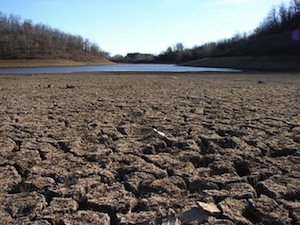Are we in one? Water officials say the answer is “Yes and No”

As state surveyors trudge into the mountains this week for the season’s second official survey of the Sierra snowpack, the auspices aren’t good. Remote sensors currently show that statewide, water content is averaging just 38% of the average for this date, and less than a quarter of what water managers would hope to see on April first — just two months away.
Consequently, the “D-word” is being nervously bandied about. Are we in a drought?
The state’s newly revamped Current Water Conditions website takes on the question with a definitive “Yes and no.” Drought status, it says “can be very different depending on your location.”
Matthew Heberger agrees. An analyst for the Oakland-based Pacific Institute and co-author of The World’s Water (Vol. 7), Heberger told me in a recent interview that it “absolutely depends on your perspective.” And that perspective is ruled by more than geography.
“I’m a hydrologist by training, so for a hydrologist, a drought would be reflected in changes in the natural environment,” he explained. “So, changes in ground water levels, lake levels, stream flows, things like that.”
Heberger went on to offer some other perspectives:
- “You have a different perspective if you’re a water manager; you care really about what’s the water level in the reservoir.”
- “An aerologist [atmospheric scientist] might define it based on rainfall levels.”
- “An agronomist interested in agriculture would say a drought is when soil moisture levels are below what you need to grow healthy crops.”
I’ll add that suburban homeowners might say it’s a drought when they’re told they can’t water their lawns. “So yeah,” agreed Heberger. “There are a bunch of different definitions for drought out there.”
It is perhaps because experts agree on the highly subjective nature of drought, that few of them seem willing to commit and say if we’re in one (or not). But most seem to agree that time is running out on the catch-up clock.
According to the Department of Water Resources, “the three-storm series that began January 19 added nearly seven inches to the northern Sierra precipitation for the year.” That brought average precipitation for the season from a dismal 30% of “normal” to more than half the average. Snow pack catapulted from 10% to 33% of average, an impressive leap from a few wet days. But there’s been little or nothing to show since then. And as the “wet season” withers, the odds portend another summer of thirsty crops, possible restrictions on urban water use, and a general increase in the number of people declaring a “drought.”
2 thoughts on “Drought Is in the Eye of the Beholder”
Comments are closed.


California fishermen might say it’s a drought when salmon and other fish don’t get they flows they need to thrive. Our Central Valley salmon need healthy flows through the Sacramento Delta to migrate to and from the streams where they reproduce. Abundant salmon mean thousands of jobs, world class recreation, and million of pounds of seafood production each year.
So all the water for the Salmon and the 25 million people and the 3.5 million acres of ag can go without water? Seems kind of narrow and very shortsighted. We need to work on getting some additional storage built for the wet years so it’s available in the dry years and that would help to maintain the cold water pools in the reservoirs to aid the migrations in the late summer and fall. There are ways that this whole thing can work if we can all work together on timing of releases and storing enough water. Also a way to get water around the delta to help wth the migration by not mixing the water through the cross channel would help too.